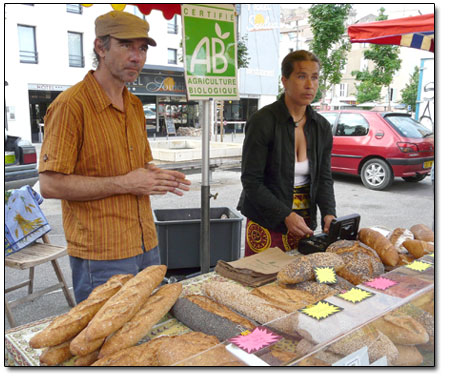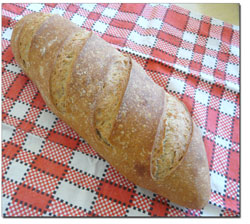|
| ||||
| A living from leaven
by C.Z. Carlin It is 8 a.m., the sun is already high above the Provençal open air in Aubagne, France, and stands overflow with farm fresh vegetables from local farms. However, among the riot of colors, a more subdued sight invites the interest of early customers – tawny organic bread sculpted in a variety of shapes, from elegant baguettes to stout, round, seeded loaves. From behind his white truck, Bernard Castellani emerges. As recently as last fall, Bernard was baking at Bread, Durango’s well-known bakery-café whose familiar logo, “Bread not Bombs,” now peeks from the boulanger’s small stand in France. In France, the title of boulanger can only be used by an artisan who bakes and sells his own bread. Bernard’s stubble beard and reddish eyes are telltale signs that he’s short on sleep and is thus responsible for the freshness of the goods on display. Were it not for his casual brown cap over a scrunched up ponytail, you might mistake him for a slightly older version of the actor Paul Giamatti, who co-starred in the iconic movie, “Sideways.” However, unlike Giamatti’s character, his grail is not the perfect wine but wholesome bread. “Grain is alive as long as we don’t eliminate the germ,” he says with conviction. “In a world where food gets to the table more and more nutritionally depleted, my bread is trying to reverse that trend.” In short order, Heather Beghtol, an ex-pat American from Durango who eagerly followed her homesick Frenchman to sunnier climes, will take charge of the stand. As the first customer approaches, Heather gets ready to practice her nascent language skills. “Un pain bis, s’il vous plait, comme d’habitude,” an elderly woman says, pointing to a plump sourdough bread with a honey-colored sculpted crust. A regular, the woman explains that this pain au levain – priced at 2.50 euros, or about $3.50 – will last her and a daughter all week if carefully wrapped in a kitchen towel. To pay for their move to France, the couple put an ad in this newspaper and sold off most of their household possessions. “At this point in my life,” says the 48-year-old Castellani, “I wanted my own business in my country, but I sure miss those mountains and especially the hot springs." His return may show good timing. French consumers have been responding to organic foods with their wallets. “Bio,” or organic, bread is protected by a special government label. However, it remains something of an elitist novelty in France, where artisans like Bernard come up against retail boulangeries, or bakeries, that turn out fresh baked bread from early morning until closing. France’s staple of choice? The national best-seller: la baguette. Some 10 billion are sold every year across the country, an average of 153 loaves for each man, woman and child. In the Mediterranean seashore town of La Ciotat, where Bernard and Heather now live, a boardwalk bakery, the Fournil des Lumieres, sells more than 1,000 baguettes a day during tourist season. Slipping discreetly into a working family’s budget, a baguette, weighing about eight ounces, costs the equivalent of a little more than a U.S. dollar. “They like’em hot… fresh out of the oven,” says the owner of his customers. Does this warm intimacy with a basic food staple account for the baguette’s overwhelming popularity in France? Nutritionally, it’s certainly no blockbuster since the healthiest part, wheat germ, has been removed from the bleached flour. While Castellani also bakes the elongated bread, its darker crust, substantial crumb and nonchemical leaven cause it to weigh nearly twice as much as an ordinary white flour baguette.
Competing for finicky French tastebuds poses unique challenges for bread bakers. In the case of sourdough, its tang and chewy texture turned out to be a flop with at least one 10-year-old, whose buttered sample ended up on a terrace floor and was quickly snapped up by hungry squirrels. So what does Castellani’s bread have that others don’t? To start with, the groundstone flour comes from a 400-year-old Provençal mill, whose grain is guaranteed pesticide-free. Bernard also prepares his own “starter,” the mix that helps the dough rise, and uses rough, pure sea salt from the Atlantic coast off Brittany. Add water plus the baker’s integrity and know how and voilà – du pain comme autrefois – bread the way it used to taste. Besides his best seller, pain bis – the 1-pound sourdough loaf that enticed that first customer in Aubagne – Castellani has also developed several specialty breads, including a regional sweetbread called gibassier. He uses local ingredients like olives, chestnuts, figs, raisins, sesame and poppyseed. Besides wheat, he bakes with rye and a variety of spelt called petite épautre de Provence as well as with the flour from an ancient grain called kamut® that used to grow in the Nile Valley of Egypt and is now known in France as pharaohs’ wheat. The baking is done in Bernard’s tiny shop Le Fournil du Riau, located less than 5 miles from La Ciotat, in the medieval village of Ceyreste. Tucked away among cream-colored houses, it’s not so much a retail outlet as a workshop with the basic equipment necessary for turning out bread. These include a stainless steel mixer, an electric oven and a “retarder,” the cold storage unit where the dough, infused with leaven, is made to rest and rise for some 12 hours. In her new French incarnation as baker’s “commis” (apprentice), Heather, 45, has learned to work the dough mixer and often shapes the various loaves. Making up for her halting French with a bright smile, she’s the one who plies the local markets to sell Bernard’s production. In Durango, she practiced as a naturopathic physician for the better part of a decade. “Bodies and bread contain a life force that I hope my hands can bring out,” she says with a wistful grin. However, it wasn’t baking but a shared love of rock climbing that brought Bernard and Heather together. Today, with the Rockies and their fabled Trimble Hot Springs 5,500 miles away, leisure time is stashed away as sweet memories. As they strain to launch a new business, the couple’s schedule can be hectic. On most days, Bernard starts at noon with what bakers call “benching,” mixing flour, water, salt and adding leaven, dividing the dough and shaping it into loaves before nestling them into baskets for cold storage. After shuttling between sales calls and deliveries, Bernard is ready to join Heather, his dedicated sales maven, for dinner and call it a day. Then, well before dawn, he’ll drive from their studio in La Ciotat and bake until seven in the morning, when Heather arrives. Together, they eat a light breakfast before loading the van to take their loaves to farmers markets, co-ops and selected resellers. Similar to the wine-making process, the most onerous investment in baking is time. For Castellani, this includes the quarter century he has spent honing his boulanger skills across the U.S. and southern France. In addition to working for Rob Kabeary, owner of Durango’s Bread, he partnered with celebrity baker Michael London and was featured in Susan Seligson’s informative and entertaining book, Going With the Grain, when she visited London’s Bakery in Saratoga Springs, N. Y. London wanted to keep him on board, but Castellani, born in the sun-drenched Camargue, found the New England winters too cold. In two years’ time, once his business has reached cruising speed and hopefully shows profit, Castellini plans to sell it and start again in a spot near the Pyrenees in southwestern France, a place that offers what he and Heather liked best about Durango: mountains for rock climbing and hot springs for conviviality. Leaning over a small iron table set outside his shop, he spells out his dream: “To celebrate my 50th birthday with our friends in Durango, lolling at Trimble.” •
|



